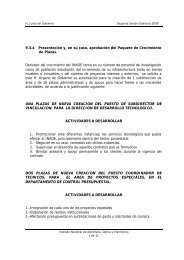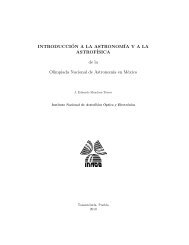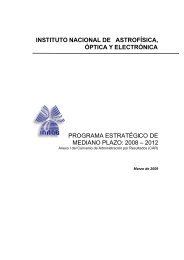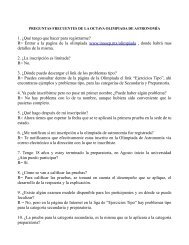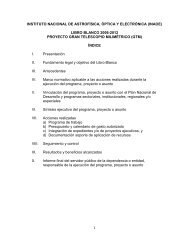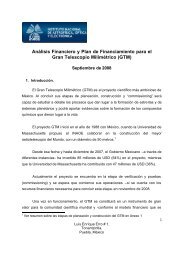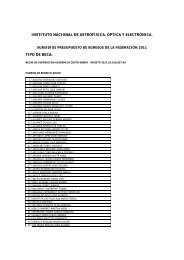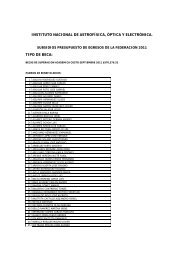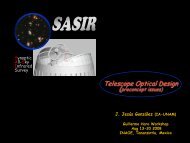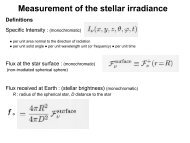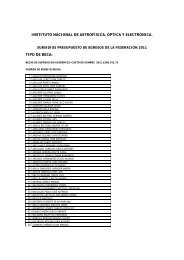Fully adaptable band-stop filter using varactor diodes - inaoe
Fully adaptable band-stop filter using varactor diodes - inaoe
Fully adaptable band-stop filter using varactor diodes - inaoe
Create successful ePaper yourself
Turn your PDF publications into a flip-book with our unique Google optimized e-Paper software.
TABLE 3 Comparison between Simulation and Measurement<br />
Results for Filter Bandwidth Tuning<br />
Simulation<br />
Measurement<br />
State FBW(%) f 0 (GHz) FBW(%) f 0 (GHz)<br />
(a) 12.96 1.47 15.93 1.43<br />
(b) 11.86 1.46 13.29 1.42<br />
(c) 10.65 1.46 11.97 1.42<br />
(d) 9.46 1.46 11.31 1.42<br />
Total fractional<br />
Total fractional<br />
<strong>band</strong>width variation: 3.50% <strong>band</strong>width variation: 4.62%<br />
TABLE 4 Comparison between Simulation and Measurement<br />
Result for Filter Selectivity Tuning<br />
Simulation<br />
Measurement<br />
State<br />
Sel. (dB/MHz)<br />
Sel. (dB/MHz)<br />
(a) 0.65 0.40<br />
(b) 0.64 0.39<br />
(c) 0.63 0.38<br />
(d) 0.58 0.38<br />
(e) 0.53 0.37<br />
Selectivity tuning<br />
range: 0.12 dB/MHz<br />
Selectivity tuning range:<br />
0.03 dB/MHz<br />
was found to be between 5 and 10 dB. A selectivity tuning<br />
range from 0.53 to 0.65 dB/MHz has been obtained.<br />
In the lower part of Figure 7, <strong>filter</strong> selectivity tuning measurements<br />
are shown. The most linear part of the <strong>filter</strong> response<br />
in the pass<strong>band</strong> to <strong>stop</strong><strong>band</strong> transition was chosen to calculate<br />
the slope and found to be between 5 and 10 dB. Varactor<br />
diode C k is reverse-biased by V k to produce a selectivity variation<br />
from 0.37 to 0.40 dB/MHz, whereas V i and V j are fixed to<br />
2 and 20 V, respectively. The reverse voltage of V k ranges from<br />
2 to 20 V. A higher variation in selectivity was observed when<br />
the bias voltage values were in the range from 15 to 20 V.<br />
Within these voltage bias values, the capacitance of the <strong>varactor</strong><br />
diode is smaller. Therefore, as the reverse voltage increases, the<br />
capacitance values decrease and <strong>filter</strong> selectivity becomes lower.<br />
Table 4 contains a comparison of simulated and measured<br />
results for selectivity tuning. The measured selectivity tuning<br />
range was limited by the parasitic capacitance of the <strong>varactor</strong><br />
diode mount, including solder pads and solder that added up to<br />
the <strong>varactor</strong> diode C k capacitance; this displaced the overall capacitance<br />
value outside the values that would give a maximum<br />
selectivity tuning. Although selectivity tuning has been successfully<br />
demonstrated, higher values of measured selectivity tuning<br />
can be obtained by accurately modeling the <strong>varactor</strong> diode<br />
mount to account for capacitive parasitic effects that can affect<br />
the overall value of C k calculated from (2).<br />
5. CONCLUSIONS<br />
Figure 7 Simulated and measured results for the <strong>band</strong>-<strong>stop</strong> <strong>filter</strong> with<br />
selectivity control (upper part: simulated response, lower part: measured<br />
response). [Color figure can be viewed in the online issue, which is<br />
available at www.interscience.wiley.com]<br />
A reconfigurable <strong>band</strong>-<strong>stop</strong> <strong>filter</strong> with a pair of transmission zeros<br />
has been proposed and successfully demonstrated. A careful<br />
comparison between simulations and measurements has been<br />
carried out to validate the design theory and implementation. Selectivity<br />
tuning for the <strong>filter</strong> has been obtained by varying the<br />
capacitance of a <strong>varactor</strong> diode situated on the crossing line that<br />
produces the cross-coupled circuit. Bandwidth tuning has been<br />
controlled by <strong>varactor</strong> <strong>diodes</strong> used to couple resonators to the<br />
main transmission line. The center frequency of the <strong>filter</strong> is controlled<br />
by <strong>varactor</strong> <strong>diodes</strong> placed at the end of transmission line<br />
resonators. The <strong>filter</strong> topology presented in this article is able to<br />
tune all <strong>filter</strong> design parameters continuously and can be perfectly<br />
adjusted to produce a fractional <strong>band</strong>width range from<br />
11.51 to 15.46%, a center frequency range from 1.34 to 1.42<br />
GHz, and a selectivity tuning range from 0.37 to 0.40 dB/MHz.<br />
ACKNOWLEDGMENTS<br />
This work has been financed by research project TEC2007-65705/<br />
TCM from the Spanish Ministry of Education and Culture.<br />
REFERENCES<br />
1. I.C. Hunter and J.D. Rhodes, Electronically tunable microwave<br />
<strong>band</strong><strong>stop</strong> <strong>filter</strong>s, IEEE Trans Microwave Theory Tech 30 (1982),<br />
1361–1367.<br />
2. S.R. Chandler, I.C. Hunter, and J.G. Gardiner, Active <strong>varactor</strong> tunable<br />
microwave <strong>filter</strong>s, Proceedings of 23rd European Microwave<br />
Conference, 1993, pp. 244–245.<br />
3. H. Uchida, A. Sato, A. Ohno, N. Yoneda, Y. Konishi, and S.<br />
Makino, A widely-tunable balanced <strong>band</strong><strong>stop</strong> <strong>filter</strong> with low reflections<br />
and separate <strong>stop</strong>- <strong>band</strong>s, Proceedings of Asia-Pacific Microwave<br />
Conference, 2006, Yokohama, Japan, pp. 641–644.<br />
4. X.-H. Wang, B.-Z. Wang, H. Zhang, and K.J. Chen, A tunable<br />
<strong>band</strong><strong>stop</strong> resonator based on a compact slotted ground structure,<br />
IEEE Trans Microwave Theory Tech 55 (2007), 1912–1918.<br />
5. W.D. Yan and R.R. Mansour, Compact tunable <strong>band</strong><strong>stop</strong> <strong>filter</strong> integrated<br />
with large deflected actuators, IEEE MTT-S International<br />
Microwave Symposium, Honolulu, HI, 2007, pp. 1611–1614.<br />
6. M.F. Karim, A.Q. Liu, A.B. Yu, and A. Alphones, MEMS-based<br />
tunable <strong>band</strong><strong>stop</strong> <strong>filter</strong> <strong>using</strong> electromagnetic <strong>band</strong>gap (EBG) structures,<br />
Proc Asia-Pacific Microwave Conf 3 (2005), 4.<br />
7. G. Zheng and J. Papapolymerou, Monolithic reconfigurable <strong>band</strong><strong>stop</strong><br />
<strong>filter</strong> <strong>using</strong> RF MEMS switches, Int J RF Microwave Comput<br />
Aided Eng 14 (2004), 373–382.<br />
8. A. Takacs, D. Neculoiu, D. Vasilache, A. Muller, P. Pons, H.<br />
Aubert, and R. Plana, Tunable MEMS <strong>filter</strong>s for millimeter wave<br />
applications, Proc Int Semiconductor Conf 1 (2006), 115–118.<br />
9. C.-K. Liao, C.-Y. Chang, and J. Lin, A reconfigurable <strong>filter</strong> based<br />
on doublet configuration, IEEE MTT-S International Microwave<br />
Symposium, Honolulu, HI, 2007, pp. 1607–1610.<br />
10. M.-S. Chung, I.-S. Kim, and S.-W. Yun, Varactor-tuned hairpin<br />
<strong>band</strong>pass <strong>filter</strong> with an attenuation pole, Proc Asia-Pacific Microwave<br />
Conf 4 (2005), 4.<br />
11. I.C. Hunter and J.D. Rhodes, Electronically tunable microwave<br />
<strong>band</strong>pass <strong>filter</strong>s, IEEE Trans Microwave Theory Tech 9 (1982),<br />
1354–1360.<br />
DOI 10.1002/mop MICROWAVE AND OPTICAL TECHNOLOGY LETTERS / Vol. 52, No. 3, March 2010 557



